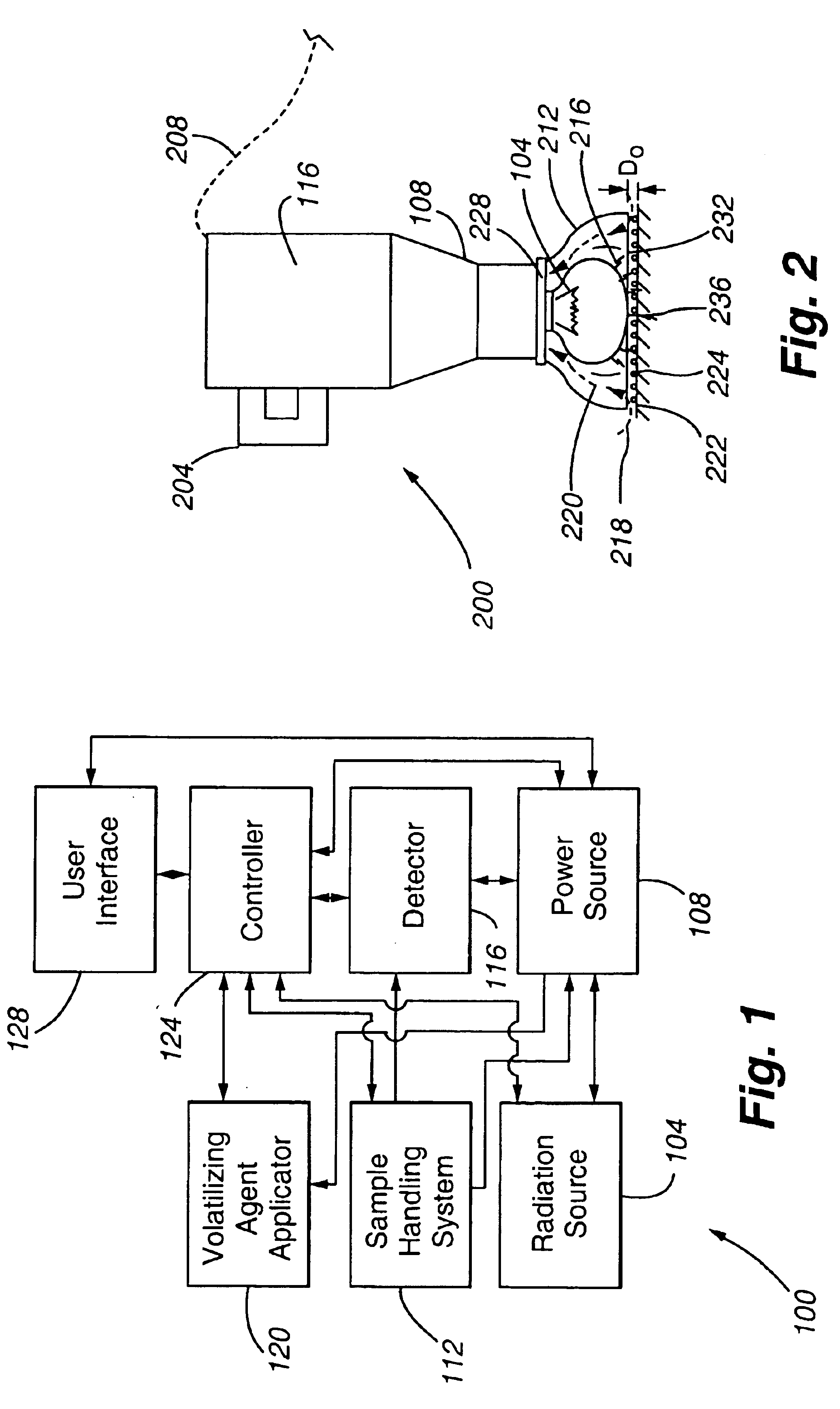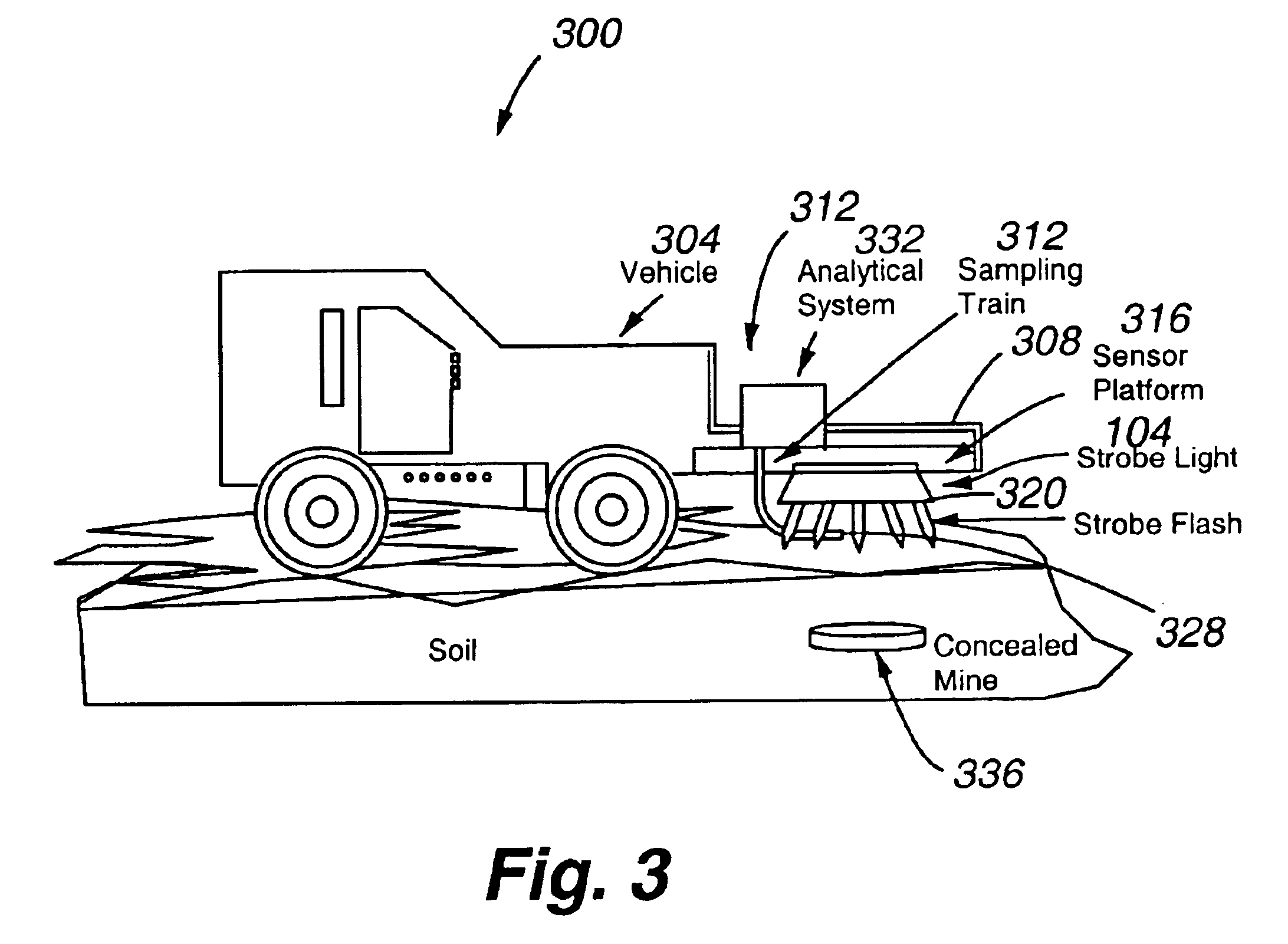Strobe desorption method for high boiling point materials
- Summary
- Abstract
- Description
- Claims
- Application Information
AI Technical Summary
Benefits of technology
Problems solved by technology
Method used
Image
Examples
example 1
[0071]FIG. 6 depicts a test apparatus used in the first example. The apparatus includes a strobe light 600, an aluminum box 604 with a sealed glass cover 608 in which a sand sample is located. A valve 612 can select a bypass 616 or a passage through the sample to the gas chromatograph (not shown). The sand sample included 1 ppm of triethyl phosphate and 1% by weight water. Triethyl phosphate is a high boiling point material, having a boiling point of 215° C.
[0072]A stream of air, having a flow rate of 64 ml / minute, was passed through the by pass 616 and into the gas chromatograph with an open 3 mm stainless steel column and flame photometric detector fitted with a 526 nm optical filter for phosphorous detection. The baseline with the gas passing through the by pass was observed.
[0073]The gas flow was then switched to pass through the box and over the sand sample. There was no inflection in the baseline, indicating that the vapor pressure of the triethyl phosphate was too low to be d...
example 2
[0078]A second test apparatus is shown in FIG. 8. The apparatus includes a 1,200 Joule strobe lamp 800, a heated inlet 804, an atmospheric pressure chemical ionization tandem mass spectrometer 808, and a test rig 812 containing TNT impregnated sand. The test rig 812 was a cylindrical test cell with a glass cover that was configured similar to that of FIG. 6. Air was drawn through the apparatus and into the inlet system of the spectrometer. The spectrometer was set to monitor the response of the molecular ion of TNT at a mass to charge ratio (m / z) of 227.
[0079]The results of one of these experiments are presented in FIG. 9. The mass chromatogram of FIG. 9 illustrates the release of a series of sharply defined plumes of vapor in response to the influx of energy from the strobe. It is also apparent that the baseline after the first strobe flash becomes elevated and analytically much noisier. It is assumed that this increase in the baseline activity is due to explosive carrying particul...
example 3
[0080]The test rig of FIG. 8 was used. Sand samples were impregnated with explosives and explosive related compounds, using dilute solutions in acetone. The concentrations were 4, 10, 25, 125, and 1,250 ppb. The solvent was removed by evaporation at room temperature. One percent water was added to each sand sample, which was then stored in the dark in a glass jar. For the tests, the sand was placed in the metal base, and the glass cover attached.
[0081]The test rig 812 containing the impregnated sand was attached to the mass spectrometer 808 via a heated glass inlet 804. Room air was drawn over the sand using the sampling pump of the mass spectrometer. The sampling rate was high (several liters per minute). The strobe light used a 15 cm diameter shade and was positioned directly above the glass of the test rig.
[0082]The mass spectrometer was set to monitor the response of the molecular ion of TNT at a mass to charge ratio (m / z) of 227. The initial test used a relatively high concentr...
PUM
 Login to View More
Login to View More Abstract
Description
Claims
Application Information
 Login to View More
Login to View More - R&D
- Intellectual Property
- Life Sciences
- Materials
- Tech Scout
- Unparalleled Data Quality
- Higher Quality Content
- 60% Fewer Hallucinations
Browse by: Latest US Patents, China's latest patents, Technical Efficacy Thesaurus, Application Domain, Technology Topic, Popular Technical Reports.
© 2025 PatSnap. All rights reserved.Legal|Privacy policy|Modern Slavery Act Transparency Statement|Sitemap|About US| Contact US: help@patsnap.com



